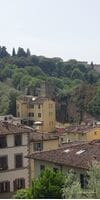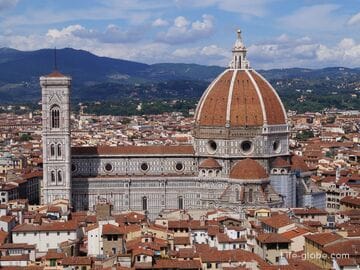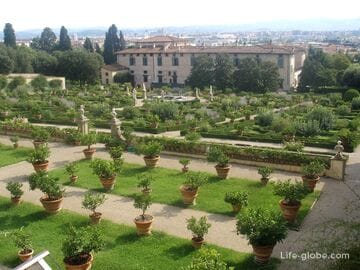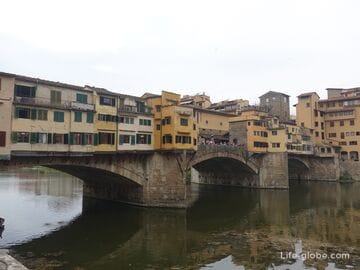Fortifications of Florence, also known simply as the walls of Florence (Mura di Firenze) - the ancient ring of the city, which performed a defensive function and consisted of fortress walls, gates, towers, forts and other fortifications.
Today, two fortresses, a bastion, parts of the walls, as well as gates and towers, which are monuments of architecture and history, remain from the former fortifications of Florence.
Some of the defensive fortifications can be visited, now they are museums and viewing platforms.
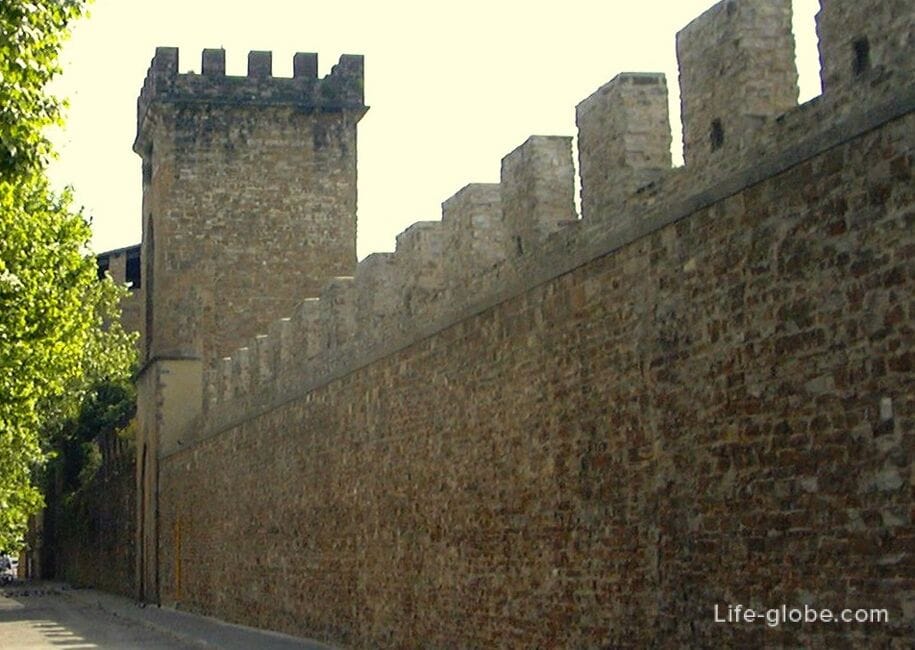
Excavations in Florence indicate that primitive walls in this area existed already between 15 and 30 years BC.
The first Roman walls stood for almost a millennium and the only "visible" remains of them are: a sign on Via del Proconsolo, between Fiorentina Abbey and Piazza San Firenze; and a section marked with a metal trace on the same street at the corner with Via Dante Alighieri.
After the first Roman walls, after the looting and destruction of the city by the Greek army of the commander Narses in 550, new walls with fortifications and gates were erected. Then they were restored, supplemented, improved, and also followed one after another, replacing each other at increasingly shorter intervals, which was the result of the growth of the city during the economic and social boom, and the rapid development of military and political power. From the Carolingian defensive circle of walls (870), the defensive belt passed to the Matilda two centuries later (1078), then just a century later to the municipal circle of walls, erected between 1172 and 1175; and, a little over a hundred years later, to the second defensive circle (from 1282 or 1284 to 1333), known as Arnolfo, because the walls were built according to a project traditionally attributed to the Italian architect Arnolfo di Cambi. The Arnolfo Wall, which was also called the New Wall, was colossal; it was six meters high and eight and a half kilometers long and contained an area that is still defined as the center of the city.
In 1530 Florence was retaken by the artillery of the papal troops and Charles V to return it to Duke Alessandro de' Medici. During the siege, it became apparent how unprepared the city was for new firearms, despite the modifications of the fortifications proposed by Michelangelo, who was responsible for the walls of the Florentine Republic before the siege. After the fall of the republic, modifications were made and the Mongibello bastion was erected (today it does not exist) and the Lower Fortress (now exists). Further, Cosimo I de' Medici also modernized the walls and bastions (almost nothing remains of them today).
Cosimo's son, Ferdinando I, continued to strengthen the city, entrusting Bernardo Buontalenti with the construction of the Belvedere Fort. This structure had the function of protection from encroachments from the outside, but above all it was aimed at protecting the townspeople in case of danger to the Medici.
The inner walls of Cosimo I, when Tuscany was pacified, soon fell out of use and already in 1571 were partially dismantled (some parts remained in the Torrigiani garden).
In the eighteenth century, Grand Duke Pietro Leopoldo left a minimal army with purely representative functions, so all military structures were abandoned and only partially transformed.
From 1865 to 1871, Florence was the capital of Italy, which led to major changes in the planning of the city and its changes. Thus began the era of the so-called Restoration, which lasted until the beginning of the 20th century, which provided for the modernization of the appearance of the city, including the demolition of walls in the northern side of Florence. Subsequently, the remaining defensive fortifications were restored and some of them turned into museums, viewing platforms and a cultural and exhibition center.
The walls in the northern part of Florence (on the northern bank of the Arno River) were demolished almost completely. Here, only the main entrance gates, several towers and the Lower Fortress, which were inserted into the new urban areas, remained of the walls.
While in the southern part of Florence, in the Oltrarno district, the walls with gates and towers, the bastion and the fort were saved from demolition and they are clearly visible today in the hilly terrain of Florence.
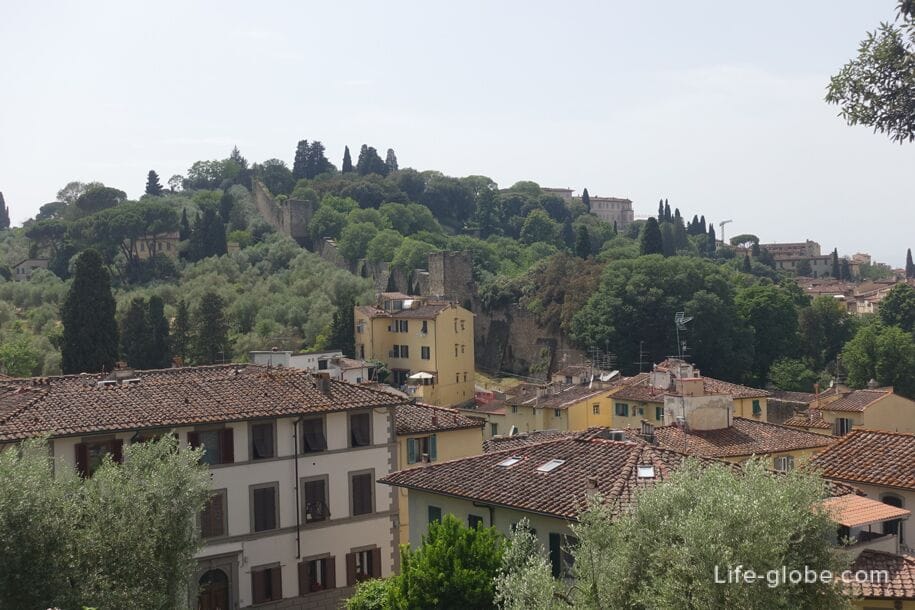
Southern parts of the city walls of Florence
The Gate of St. Nicholas (Porta San Niccolo, Porta San Niccolo), which, because of its current appearance, looks more like a tower.
The gate was erected in 1324-1345 according to a project attributed to the Italian architect Andrea Orcagni.
The height of the tower is about 45 meters, and has a 14th-century fresco depicting the Virgin and Child between Saints John the Baptist (patron saint of the city) and Nicholas the Wonderworker (patron saint of the district).
During the summer months, from about June to the end of September, the tower can be visited at certain hours. The visit includes a guided tour, during which you can climb to the top of the tower and admire the panoramic views of the city. More about the Gate of St. Nicholas…
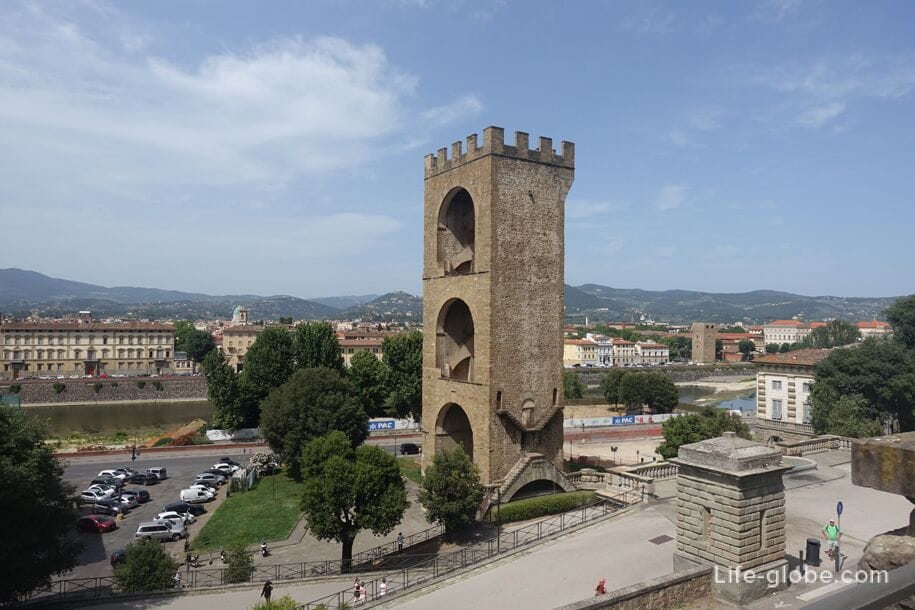
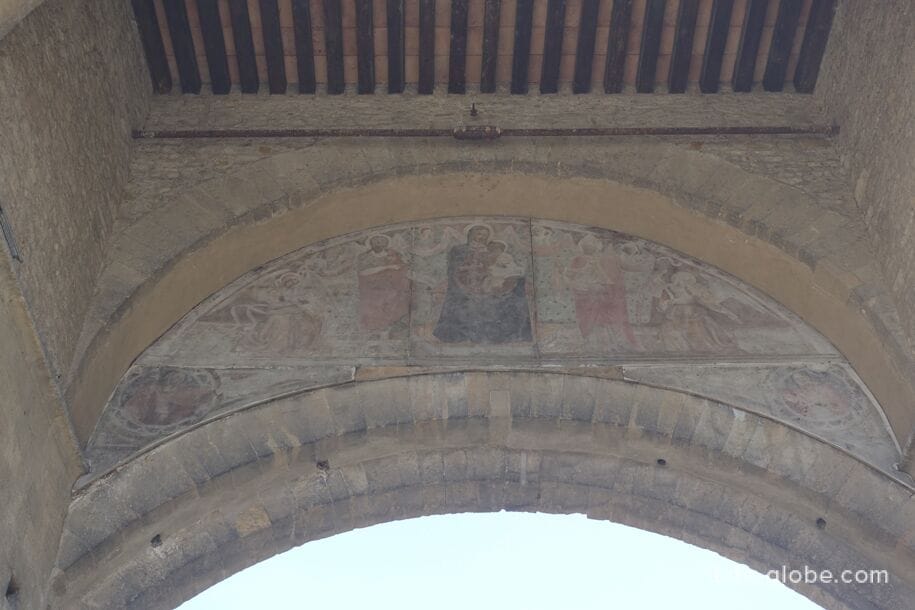
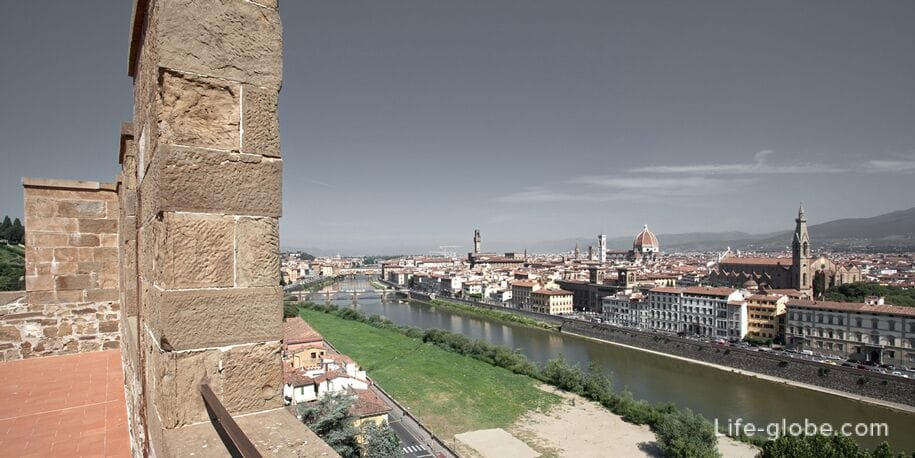
For information about the possibility of visiting the Saint Nicholas Gate Tower, opening hours, ticket prices, etc., we recommend that you check the official website: musefirenze.it. Also on the website you can find out information about possible visits to other towers, gates and forts of Florence (described later in the article).
The Gate of Saint Miniato (Porta San Miniato, Porta San Miniato), built in 1320 and having a structure different from all the other gates of the city, since they do not have a tower. Sentries guarded the area using a passageway above the gate, the entrance staircase of which is still visible.
On the outside of the gate there are two coats of arms depicting the symbols of the municipality.
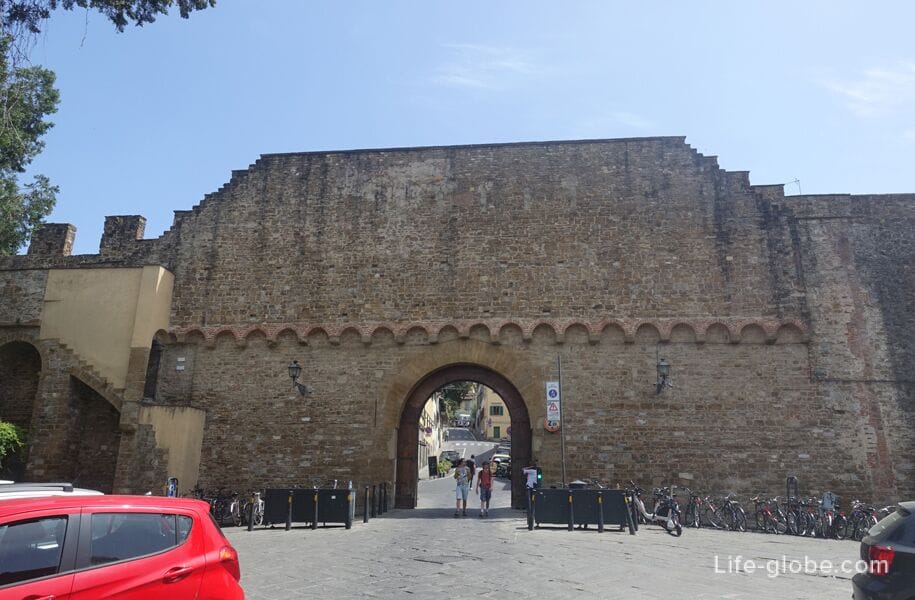
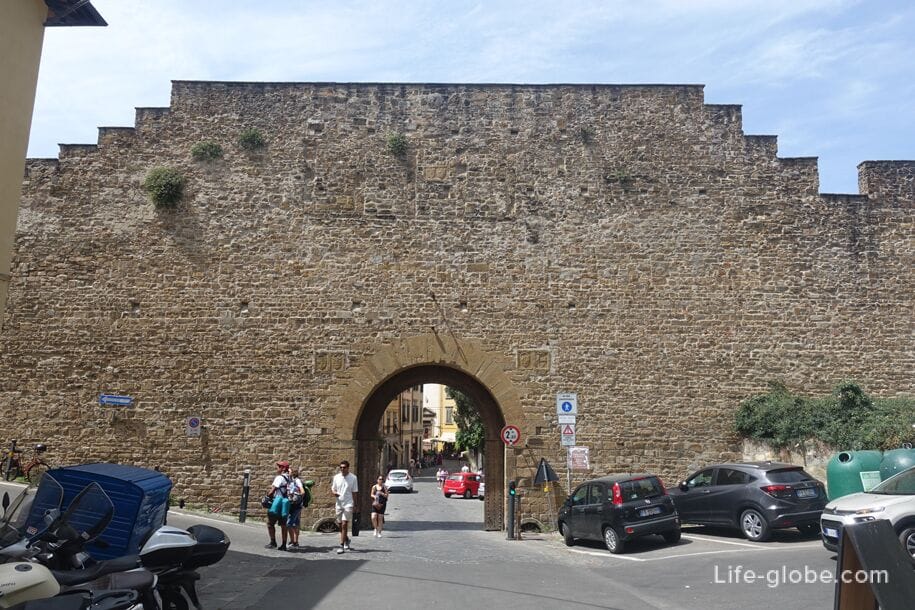
From the gate of St. Miniatus along the Belvedere Street (via di Belvedere) passes the city wall with towers.
Florentine coats of arms also testify to the large number of towers that existed here.
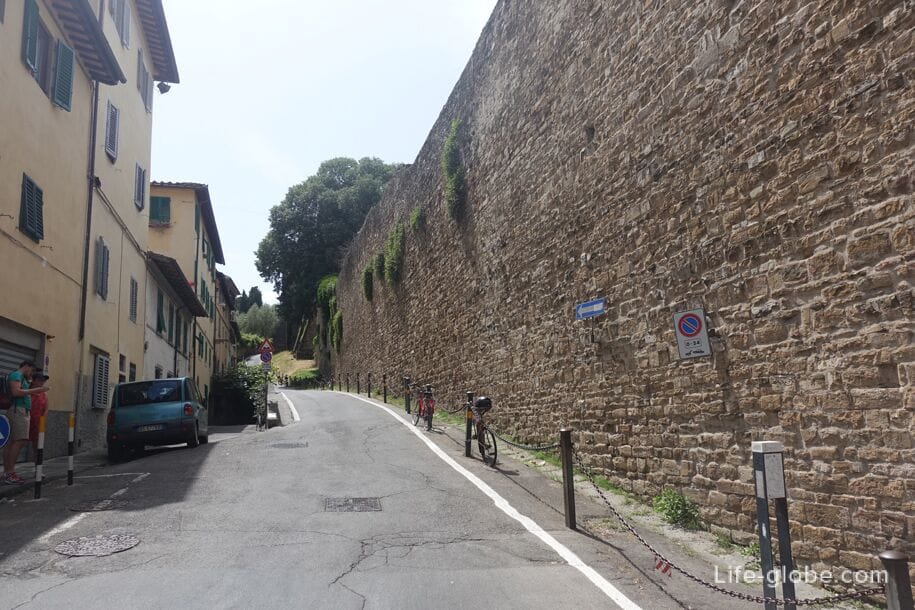
Along the wall is the bastion of San Giorgio (Baluardo a San Giorgio), also called the Geneva Bastion (baluardo della Ginevra) due to the presence of a nearby spring known as Geneva.
This site belongs to the district of the defensive walls of 1258 and was built at the behest of Cosimo I de' Medici in 1544 on one of the bastions erected by Michelangelo Buonarroti on the occasion of the siege of Florence in 1529-1530.
The bastion includes one of the towers and a strongly inclined section of the walls themselves.
Currently, the bastion is the headquarters and shooting range of the Florentine company of crossbowmen and the Florentine historical Football procession, who take care of the maintenance of the bastion.
The Bastion can be visited on certain days and hours.
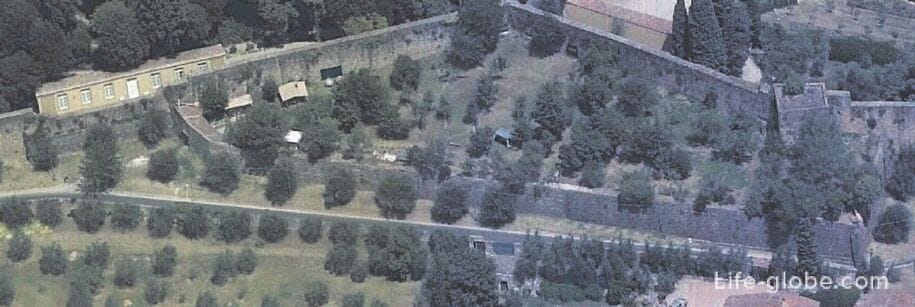
The Gate of St. George (Porta San Giorgio, Porta San Giorgio), built in 1324.
In view of the siege of Florence in 1529, the portal of the gate was lowered at the suggestion of Michelangelo, who was then responsible for the fortifications of the city, so that the gate would be less vulnerable to cannon fire.
On the outer facade of the gate is a double arch with a bas-relief of the fourteenth century in the lunette, "St. George killing the dragon", by Andrea da Pontedera (now it is a copy, and the original is kept in the Palazzo Vecchio).
On the inner side of the gate there is a fresco "Madonna enthroned with the Infant and Saints Leonardo and Giorgio" by the Italian artist Bicci di Lorenzo.
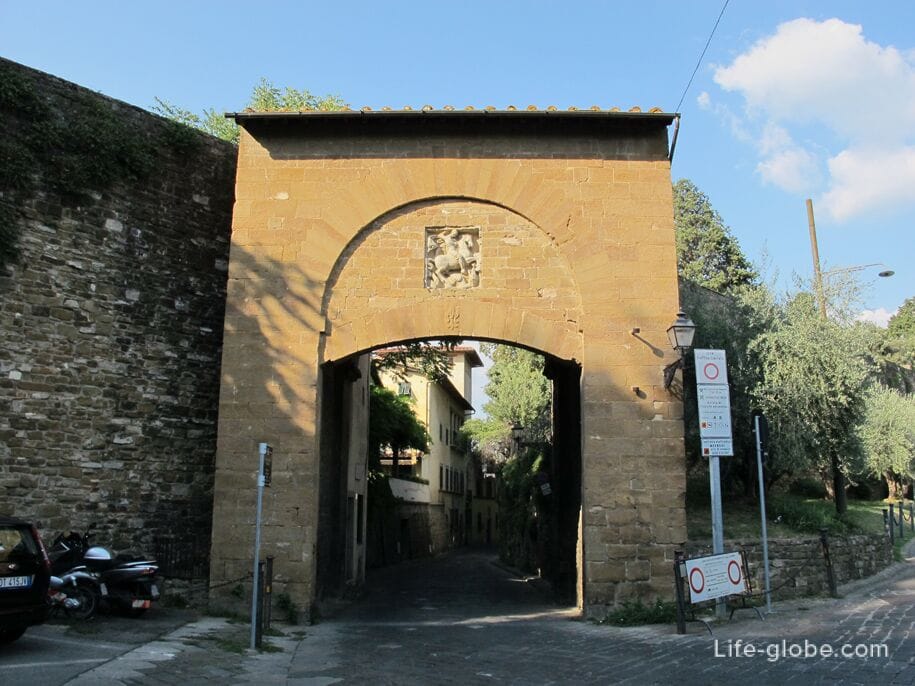
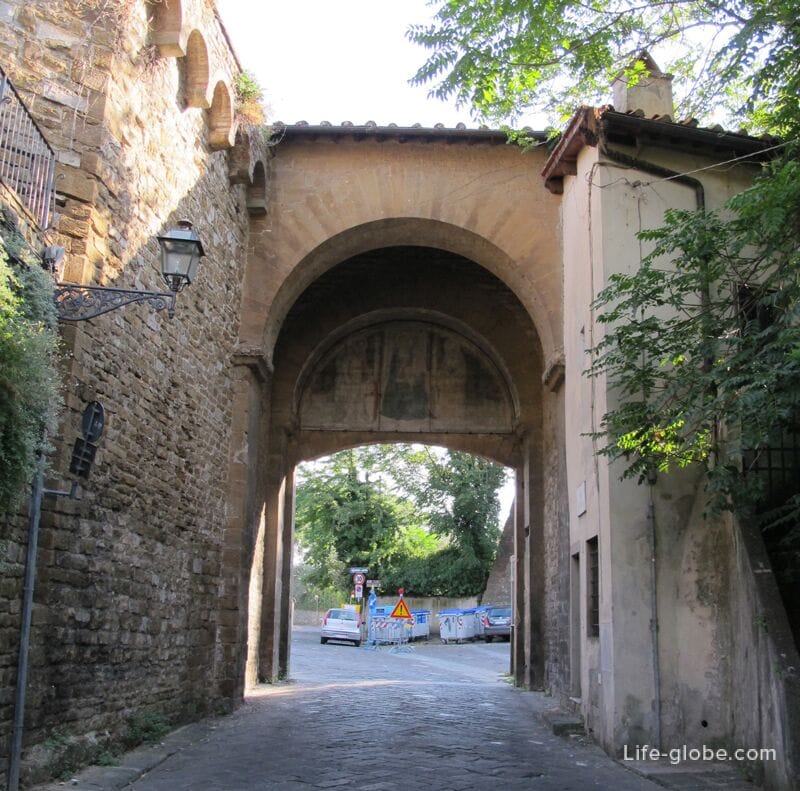
Next is the unsurpassed Fort Belvedere (Forte di Belvedere) or Fortezza di Santa Maria in San Giorgio del Belvedere (Fortezza di Santa Maria in San Giorgio del Belvedere Firenze) - the city fortification of the late 16th century, which today can be visited - where exhibitions are held, and which is one of the best viewing platforms of the city.
The fortress was built by the Italian architect Bernardo Buontalenti between 1590 and 1595 by order of Grand Duke Ferdinando I de' Medici. Michelangelo was the chief engineer of the fortifications. The fortress was built near the defensive walls and bastion.
The fortress is located on a high hill, has a polygonal plan and a small villa in the center. The villa is the central building that served as the residence of the Grand Duke in unhealthy times and did not conform to the military principles that the rest of the fort obeyed, but rather as the "Villa Medici", which is a visible sign that it was a fortress-villa, both for personal residence and for protection. More about Fort Belvedere…
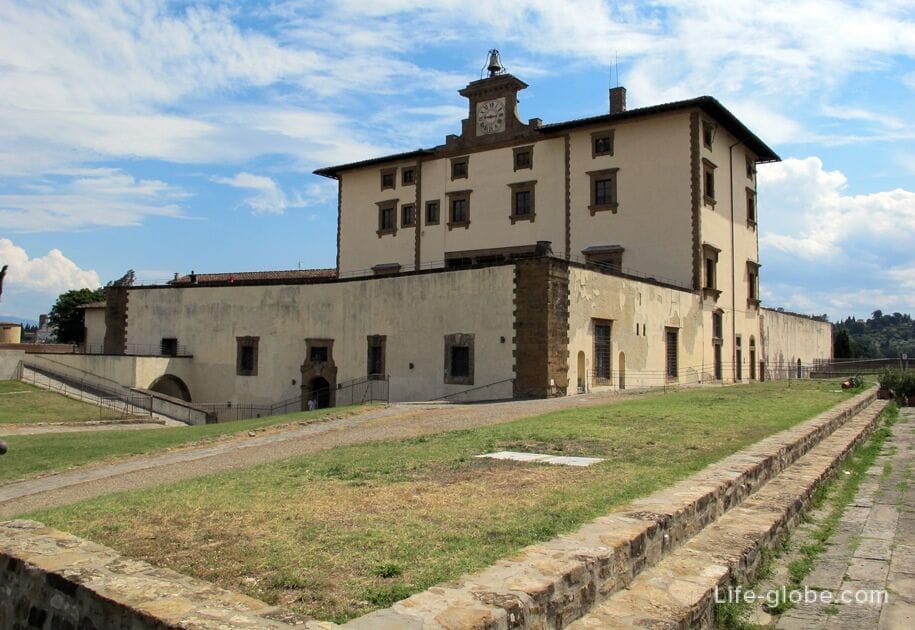
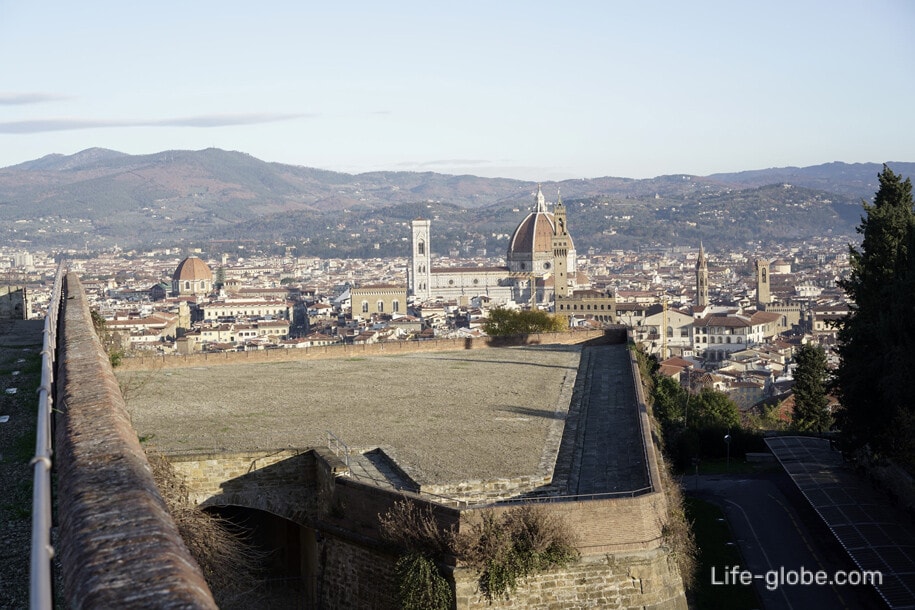
Further, the wall with towers runs behind the beautiful Boboli Gardens, which were part of the residence (Pitti Palace, now a museum) of the Medici, then the Habsburg-Lorraine and Savoy dynasty.
Today Boboli Gardens can be visited, they are the most famous and beautiful park in the city, as well as one of the most important examples of an Italian garden in the world and a real open-air museum.
In the Boboli gardens there is a bastion of Knights (Il Bastione del Cavaliere, Bastion del Cavaliere), which was previously part of the fortifications built by Michelangelo in 1529 before the siege of the city. A garden with a fountain is now laid out above the bastion. More about Boboli Gardens…
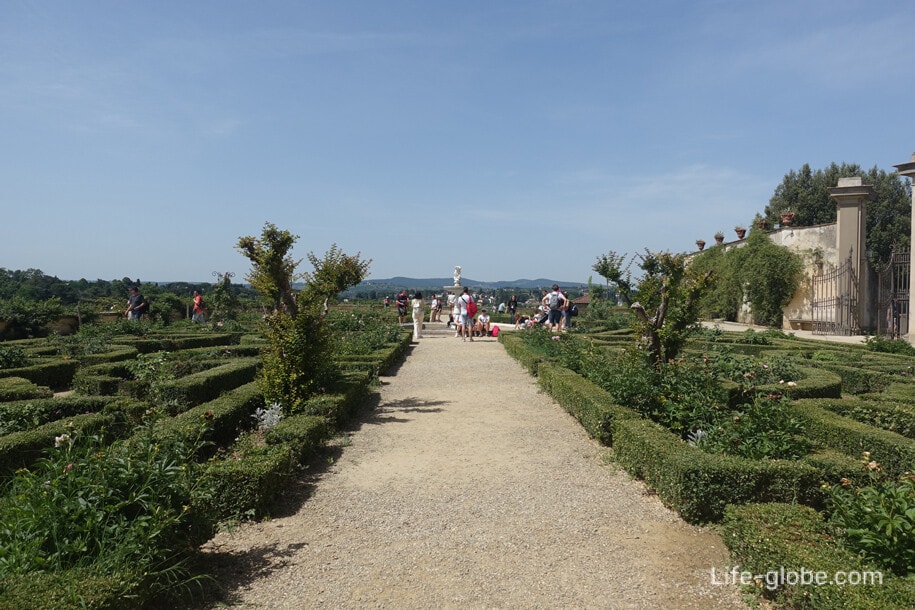
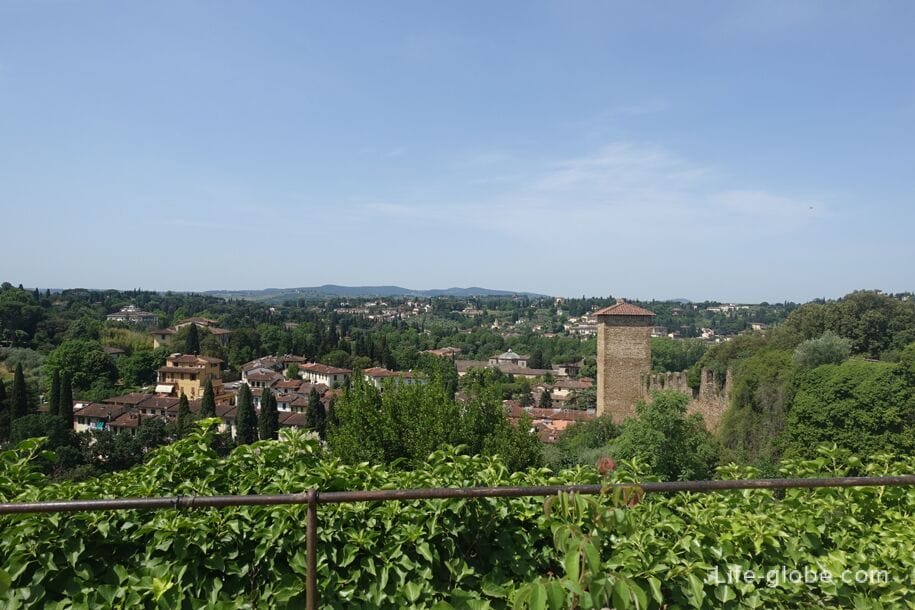
The Roman Gate (Porta Romana, Porta Romana) is the southernmost gate of the walls of Florence, located on the road leading to Siena and Rome (hence the name of the gate).
The gate was built between 1328 and 1331 as part of the work on the last tier of the walls. Like most other city gates, they were lowered in the sixteenth century to make them less vulnerable to artillery fire.
The gate has a large central and smaller side arches. On the sides of the large central arch there are two symmetrically arranged inscriptions in Latin: the first in memory of the solemn entry into the city of the Medici Pope Leo X during a journey that would lead him to meet with King Francesco I of France (1515) in Bologna; the second, in memory of the arrival of Emperor Charles V, who arrived in Florence to make Alessandro de' The Medici duke of the city and give him his daughter Margarita in marriage (1536).
There are poorly visible shields above the inscriptions. There are also horseshoes and flagpoles of different designs on the gates, possibly ancient in some cases. Inside the arch, in the lower left corner, there is a modern stone that indicates the distance to the gate from Piazza della Signoria (1570 meters).
In the inner lunette, as in most other ancient preserved gates, to emphasize that the territory was under the protection of the Virgin, there is a fresco of the early sixteenth century (separated in the seventies of the twentieth century, and then restored) depicting the Madonna and Child between Saints John the Baptist, Zanobi, Pietro and Nicola da Tolentino, the work of the Italian the artist Francabijo.
On the side facing the city, there is an inscription with the location of 1327, which indicates the size of the structure at that time.
Today, the gate can be visited on certain days and hours, as well as admire the views of the city from the top of the gate.
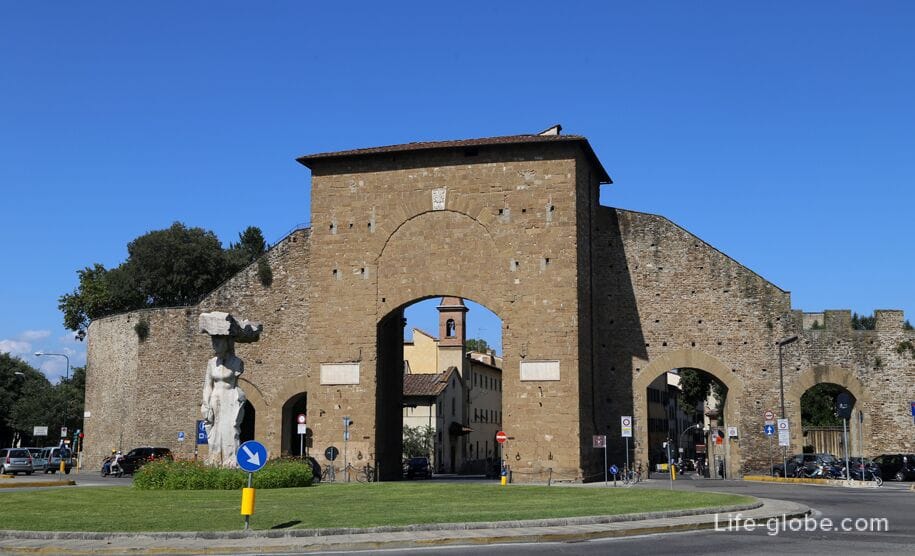
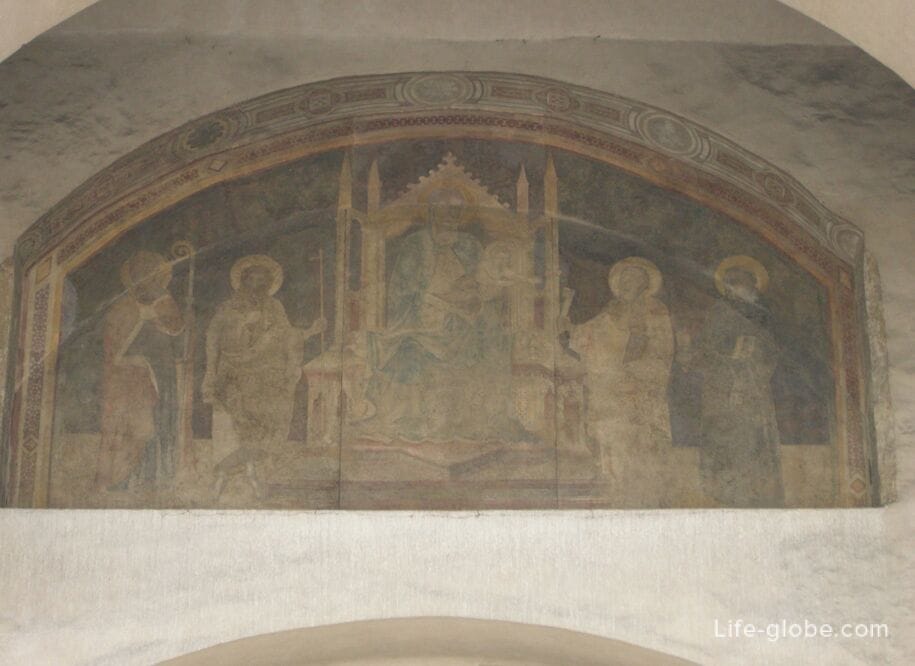


This is followed by the Gate of St. Ferdinand (Porta San Frediano, Porta San Frediano) and the Tower of the Holy Rose (Tabernacolo di Santa Rosa, Tabernacle di Santa Rosa), connected by a section of the wall.
The San Frediano Gate was built between 1332 and 1334 on a very important road to Pisa according to a design attributed to Andrea Pisano. Judging by its size, it was the most majestic door in the wall, but its height remained unfinished; then the passage was lowered and strengthened in the years immediately preceding the siege of Florence. On the side facing the city, the coat of arms of Florence is placed on top of the arch.
The grandiose wooden gate door with bolts is original, as are forged rings for tying horses and forged holders for torches. The keys to this gate are kept in the Palazzo Vecchio.

The Santa Rosa Tower is notable for the niche (edicule) of 1856, in which there is a fresco depicting a Pieta with Saints John the Theologian and Mary Magdalene, attributed to Ridolfo del Ghirlandaio (early 16th century).
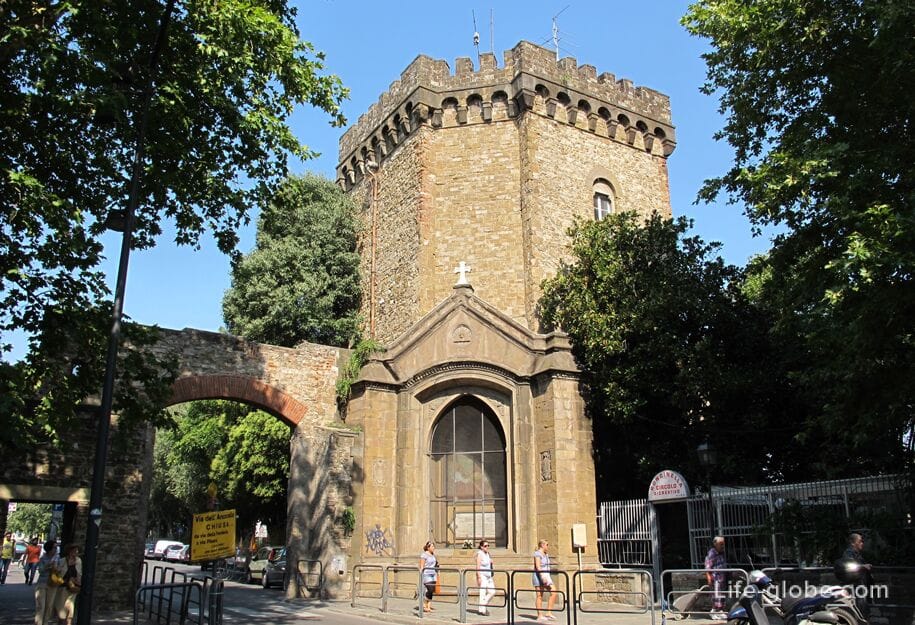
The northern remains of the fortifications of Florence
In the northern part of the city, among the former fortifications, two buildings are particularly noteworthy:
- The lower fortress or fortress da Basso (Fortezza da Basso, Fortezza da Basso) of the 16th century, which is built into the defensive walls of the city and on the territory of which various conferences, exhibitions, concerts and events are held today; you can also visit the fortress with an excursion, during which you can admire the panorama of Florence and go down to the underground passage of the fortress.
The fortress was built by the architects Pier Francesco da Viterbo and Antonio da Sangallo the Younger in the period from 1534 to 1537 by order of the Duke of Florence Alessandro de' Medici, also called the Moor.
Website: firenzefiera.it. More about the Lower Fortress...

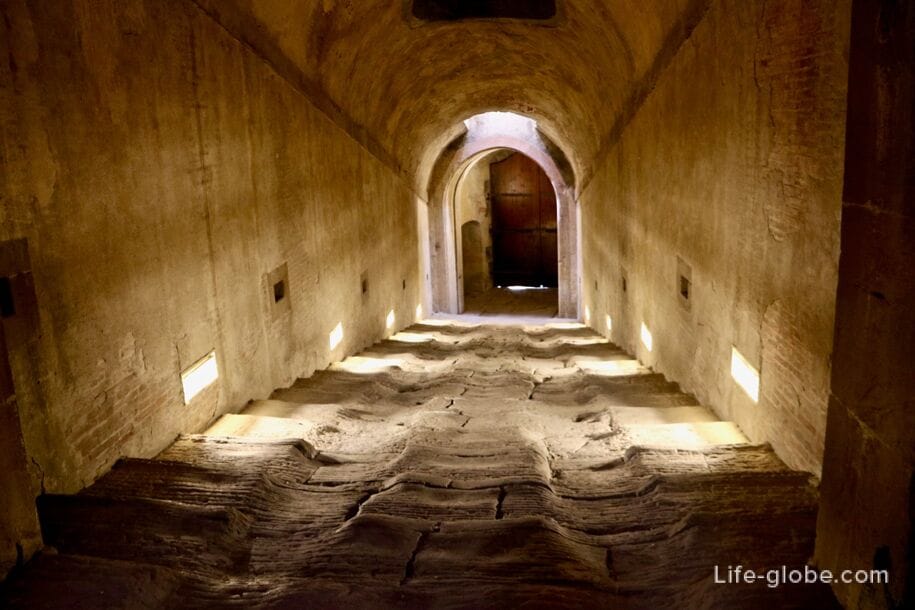
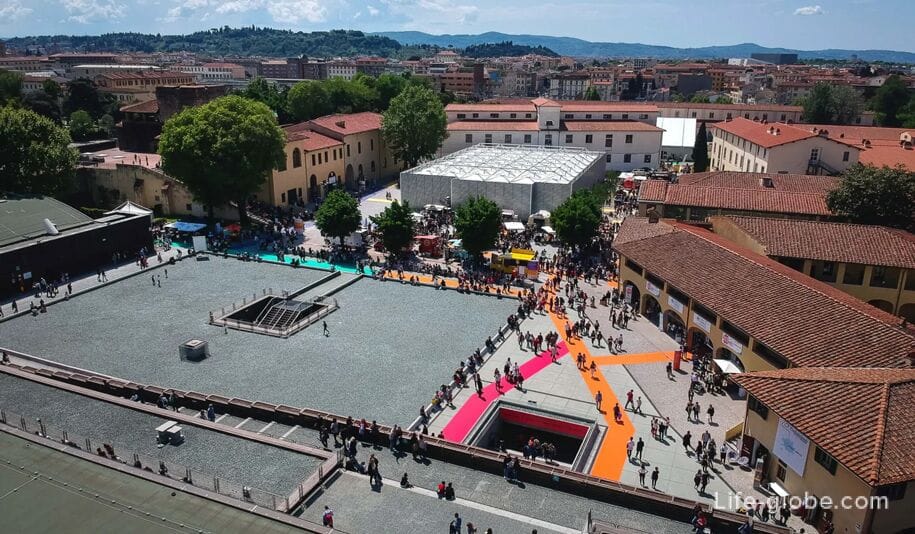
- Coin Tower or Mint Tower (Torre della Zecca / Torre della Zecca Vecchia), which closed the walls of Florence towards the Arno in the east and was actually one of the "terminal towers" along the perimeter of the city wall. Before the construction of the mint in the immediate vicinity of the mills, the structure was called the Notomskaya tower, or the observation tower.
The tower had a height of 25 meters and was erected between 1320 and 1324, primarily for protection from the Arno River, as well as the unfinished Royal Bridge over the river.
In the Lawrence era, ammunition was stored in the tower: weapons, tools and explosives (gunpowder, saltpeter).
Today, the tower is what remains of the fortifications in this place, as well as from the mint complex, from which the tower got its name when hammers used for minting Florentine coins and, in particular, the famous Golden Florin worked in the rooms under water.
From the outside, the tower is simple and massive, with small slits and without a crenellated crown. On the side facing the city there is a gate with an iron standard-bearer of the twentieth century, and on the side facing the Arno there is a plaque with some verses of Dante dedicated to the river: "Halfway through Tuscany you can see the river that originates in Falterone, and the hundred miles of Corso are not filled."
Today the tower can be visited. On the top floor there is an outdoor terrace with panoramic views of the city. Inside there are vaulted rooms connected by a narrow stone staircase, once used by the keepers of the arsenal.

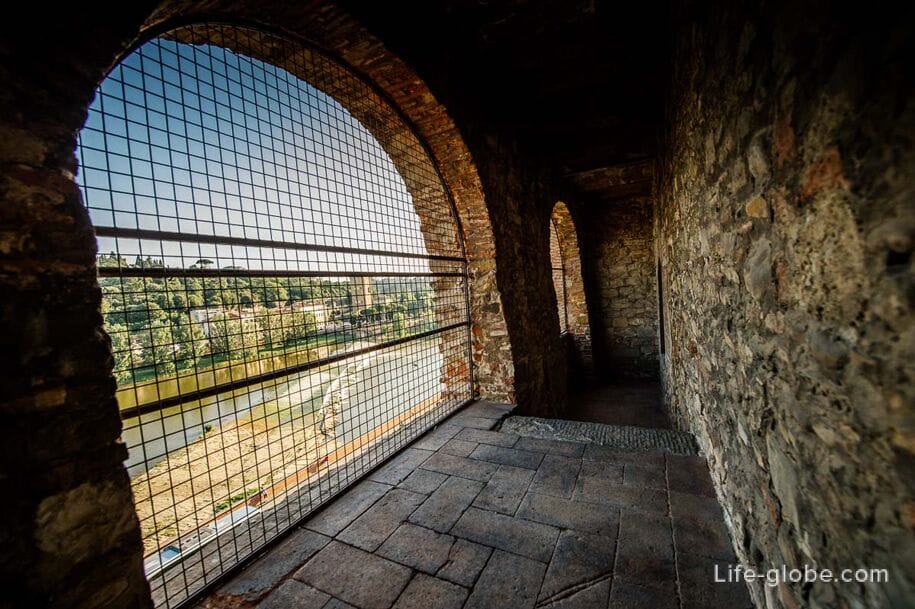
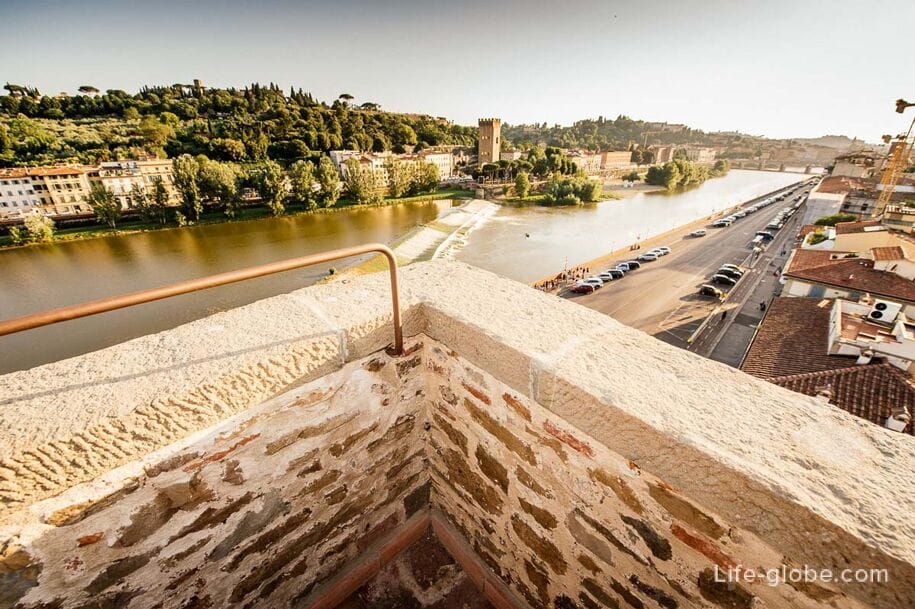
Other detached towers and gates on the north side of Florence:
- Serpentine Tower or Serpe Tower (Torre della Serpe, torre della Serpe), which was part of the Florentine walls of the 13th-14th centuries.
It served as a guard function and was once located next to the back door, that is, a small door hidden in the walls, which was used by military patrols.
The structure of the tower is quite simple, with an original jagged "crown";
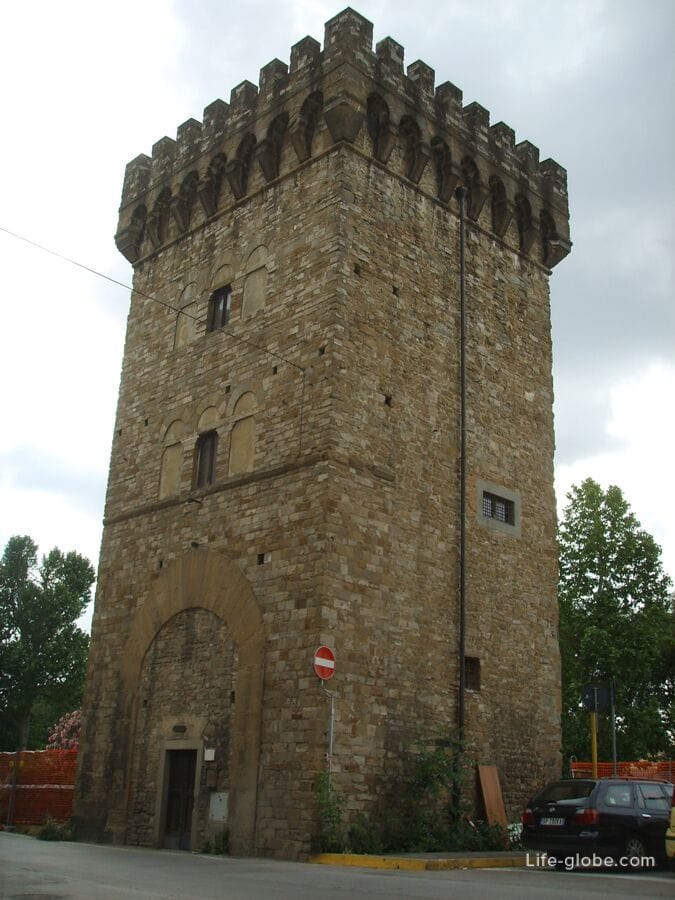
- The Prato Gate (Porta al Prato, Porta al Prato), which is one of the oldest surviving gates of the city, dating back to 1285.
From the gate begins the road leading to the city of Prato (hence the name of the gate).
The gates were lowered in 1529 and modified to make them less vulnerable to cannon fire.
The gate has a large arch, a loggia with a sloping roof above it (the current result of the reconstruction of the early 1930s), topped with a weather vane.
Inside the gate is a lunette with a sixteenth-century fresco depicting the Madonna and Child between Saints John and Cosimo, attributed to Michele di Ridolfo del Ghirlandaio. Now the fresco is kept in the conference hall of the Biblioteca delle Oblate.
In marble inserts on the walls of the gate, epigraphs are recorded: the first speaks about the size of the walls, the tower and the defensive moat; and the other recalls the fallen in the area in World War II;
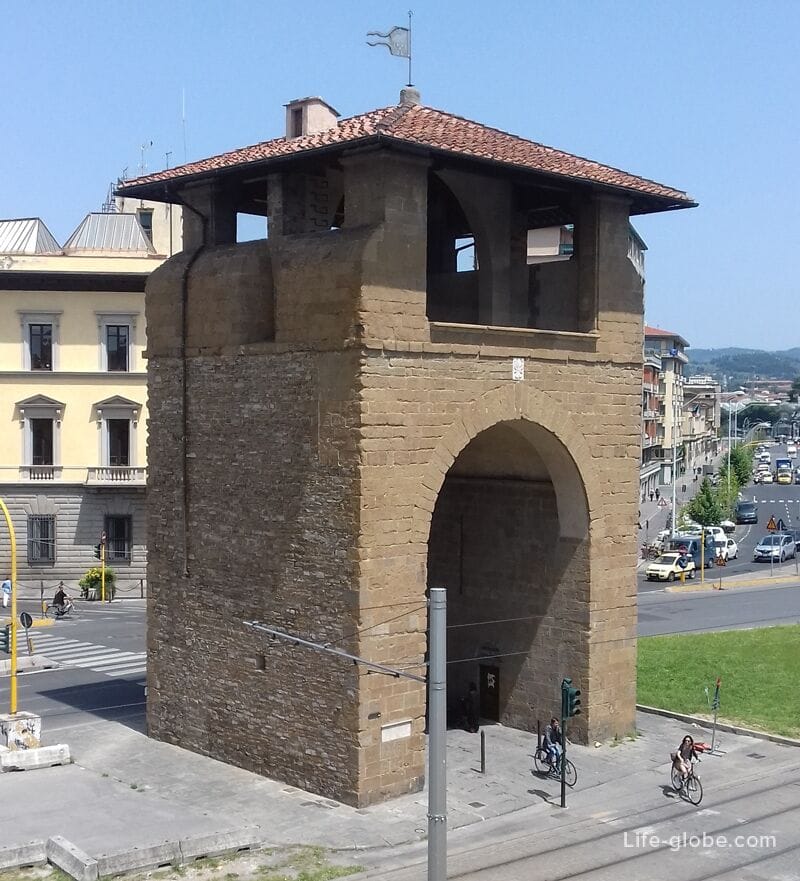
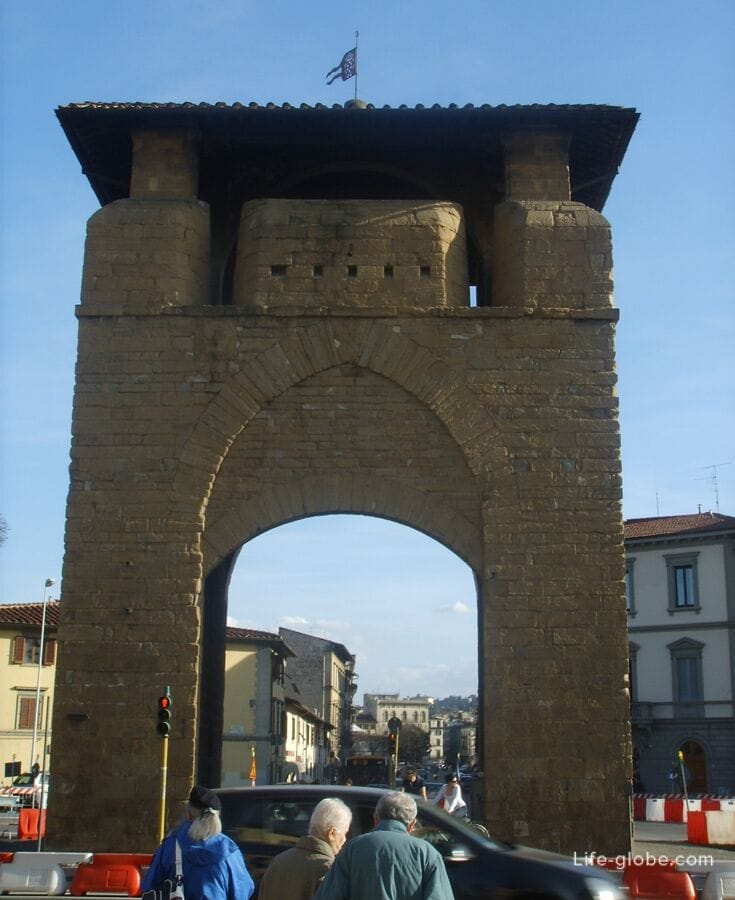
- the gate of St. Galla or St. Rooster (Porta San Gallo, Porta San Gallo), which was one of the gates of Florence through which the most intense traffic passed, because they were the northernmost and connected to the road to the city of Bologna.
On the gate door, the keys of which are still kept in the Palazzo Vecchio, an inscription marks the foundation of the gate in 1285 at the initiative of the Guelph commander Rolandino da Canossa, and another, later inscription on the gate marks the transition of King Frederick IV from Denmark, who in 1708 became the protagonist of an awkward episode of love in the city.
The outside of the gate is decorated with two marzocchi, or lions of the Guelph Parte, made of stone, and in the inner lunette there are traces of a fresco with the Madonna and saints.
The gate is located on Liberty Square, opposite the Triumphal Arch of Lorraine, erected in 1737 to commemorate the arrival of the Lorraine dynasty in the city;
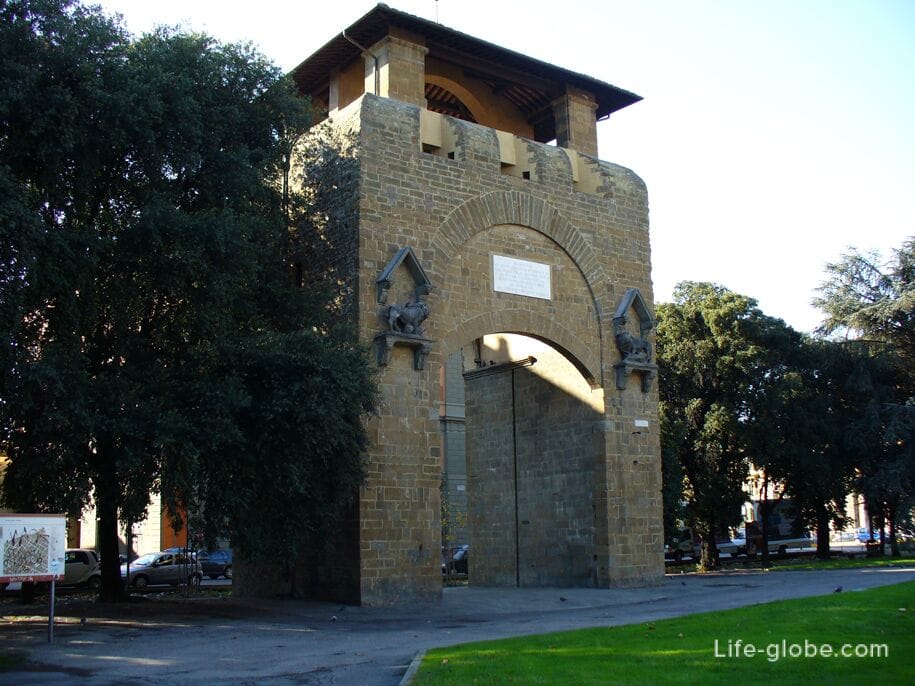
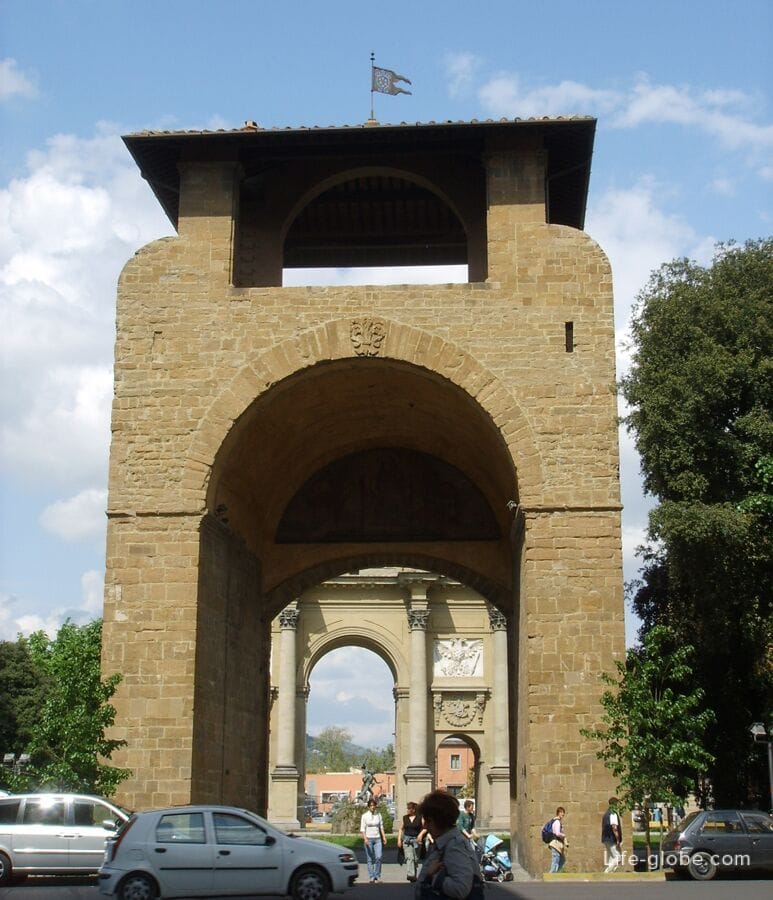
- The gate leading to the Cross (Porta alla Croce), also known as the gate of Santa Croce (Porta Santa Croce, Porta Santa Croce).
The cross that gave the name to the gate, called "Croce al Gorgo", was located a little further towards the Arno River and, according to legend, marked the place where the Florentine First Martyr San Miniato was beheaded, from where he, having already been executed and raising his head, went to the hill on the other side of the Arno, where he stopped in his the cave and where the Basilica of San Miniato al Monte now stands.
As in other cases with the city gates, the original design of the gate (which is assumed to belong to Arnolfo di Cambio and dates back to 1284) has undergone various transformations over time, most notably in the sixteenth century, with its height decreasing on the occasion of the siege of the city of 1529-1530.
In the inner lunette of the gate there is a sixteenth-century fresco (removed and replaced by a reproduction, the original is in the Oblato Library) depicting the Madonna and Child with Saints John the Baptist and Ambrose, attributed to Michele di Ridolfo del Ghirlandaio.
On the side of the gate facing the Arno, there is a large slab of red marble, located under the cross of the Florentine people, in memory of those who fell in the area during the war of 1915-1918, and at the bottom there is a small fountain.
On the side facing the city, there is an inscription with data on the size that the structure had in 1310. On the side facing the countryside, above the arch is another marble plaque with a long inscription dictated by "Mr. Cavalier Zannoni antiquario reggio" (Florence, 1850), in memory of the new roads leading to Casentino and Romagna.
Inside there is a milestone marking the distance from Piazza della Signoria to these gates (1,540 meters), and a level marking the water level reached during the flood in Florence in 1966.
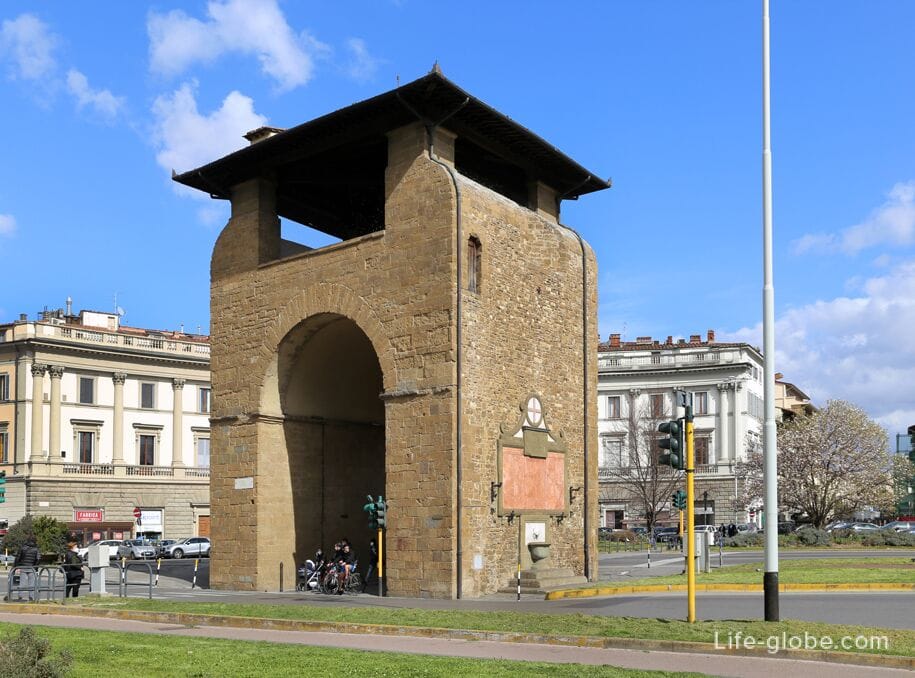
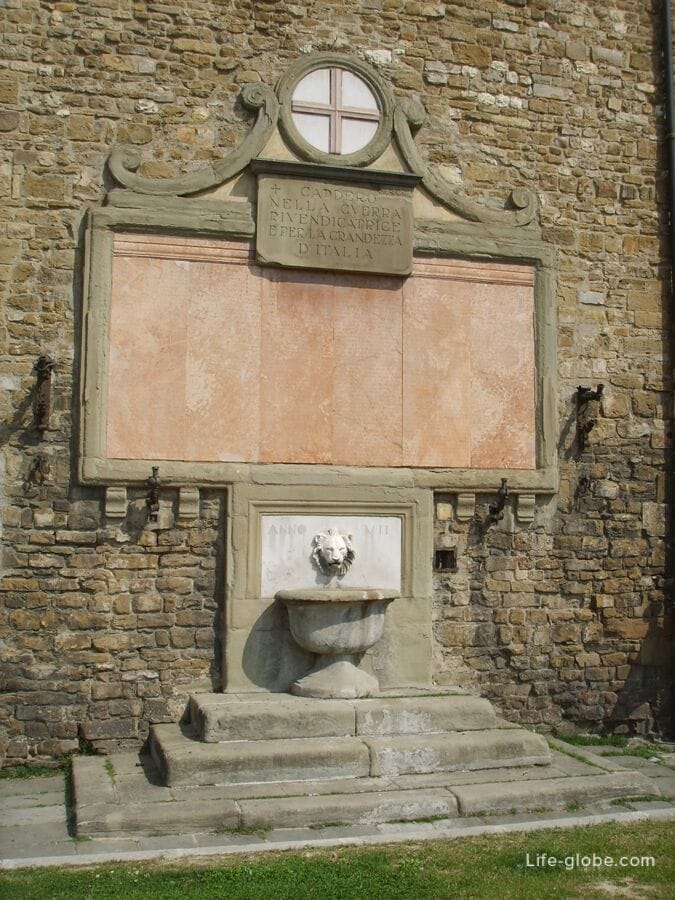
Remains and marks of fortifications in the oldest part of Florence
In the oldest part of the center of Florence, the historical center of the city, there are small remains and mentions of the earliest city fortifications of Florence.
The Gate of Aquilonia (Porta Aquilonia, Porta Aquilonia), which was an ancient gate in the walls of Florence, belonging to the first Roman circle.
Initially, the gate was located between the present street of Rome and Piazza San Giovanni, and then it was moved between Piazza San Lorenzo and Via Ginori, where this place is marked by corner masonry.

On the Piazza Santa Croce, outside the Palazzo Cocchi-Serristori, in the resega of the wall on Via dell'anguillara, there is a real relic of the medieval city, that is, the loop of the ancient city gate, opened in the second tier of the walls and possibly bearing the name of Porta a San.Simone. Here, on the wall of the building, an ancient erased coat of arms is visible.
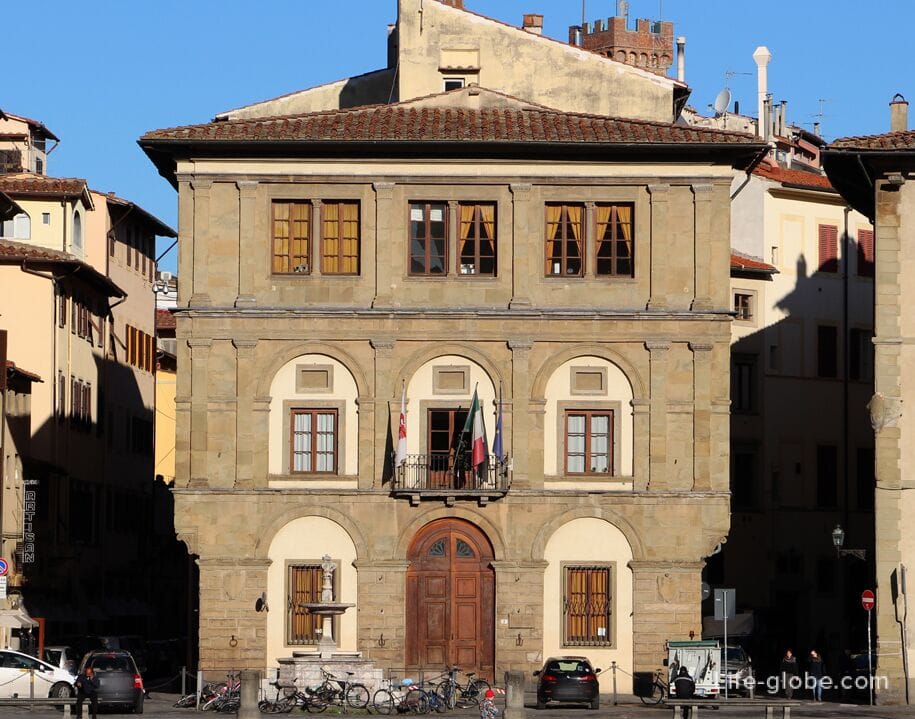
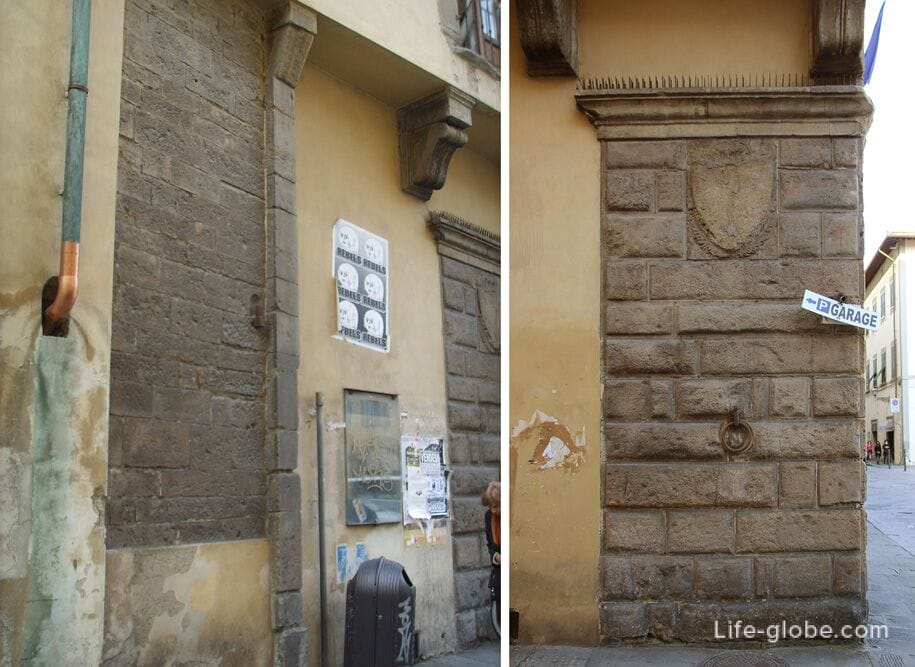
The Pagliazza Tower (Torre della Pagliazza), located on the small Piazza Sant'elisabetta and considered by many to be the oldest surviving building in Florence (built by the Byzantines in the 6th century), has retained its original appearance (now restored), although it stands on an older foundation of the Roman era, which, as some believe, was part of the fortifications of the city; whereas perhaps it was just a tower house or even earlier part of a Roman aqueduct.
One thing is for sure, the semicircular structure of the structure is almost unique in Florence.
Today, the tower is part of the 4-star Brunelleschi Hotel with a private archaeological museum, restaurants, a fitness center, meeting rooms and free Wi-Fi. Link to the hotel

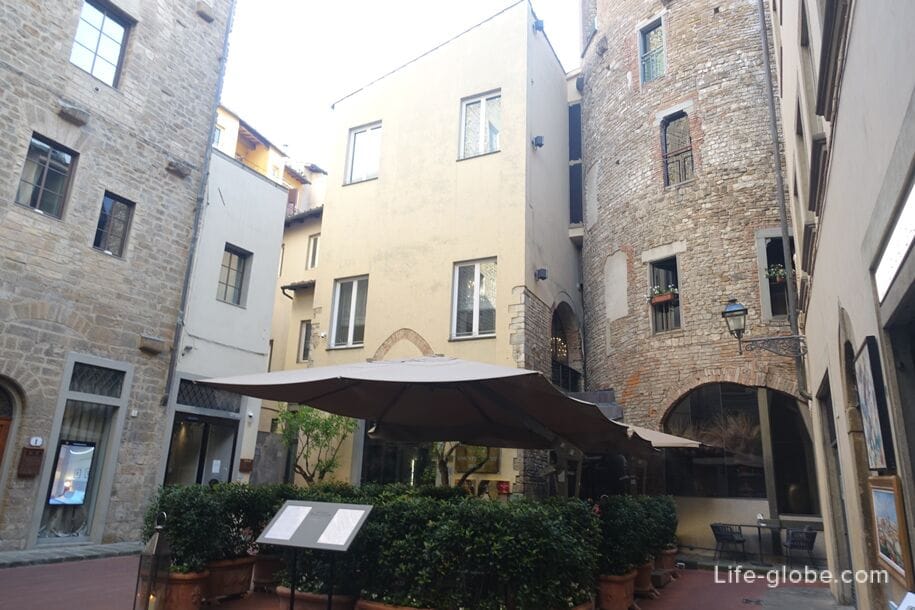
The Arch of San Pierino (Arco di San Pierino), which is a covered passage between Piazza San Pier Maggiore and Oriuolo Street at the corner of Sant'Egidio and Borgo streets Pinty.
The passage should not be confused with the arch of the seventeenth-century loggia, much more noticeable in the Piazza San Pier Maggiore, which is the remains of the ancient church of San Pier Maggiore (chiesa di San Pier Maggiore), destroyed in the eighteenth century. What we need is a long covered passageway and a much older one made of stone blocks.
It is believed that these are the remains of the ancient city walls of Florence, built between 1173 and 1175, which immediately turned at an angle to the south, to the Arno. Since the time when the arch was a defensive structure, several hatches have remained in the ceiling of the passage, mostly walled up, but one of which still has a wooden roof.
View from Borgo Pinti street
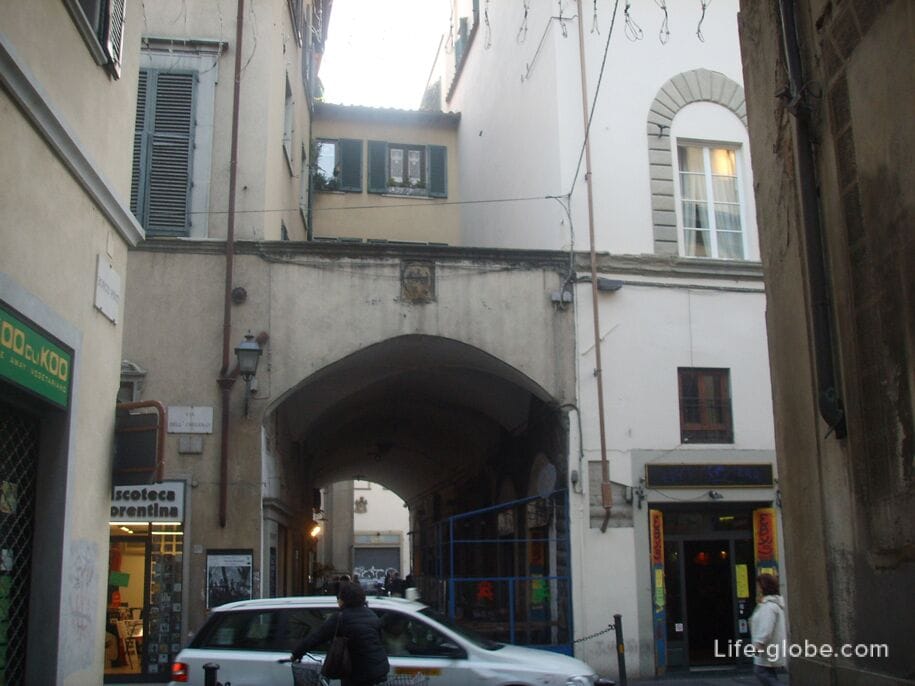
View from the side of the Piazza San Pier Maggiore
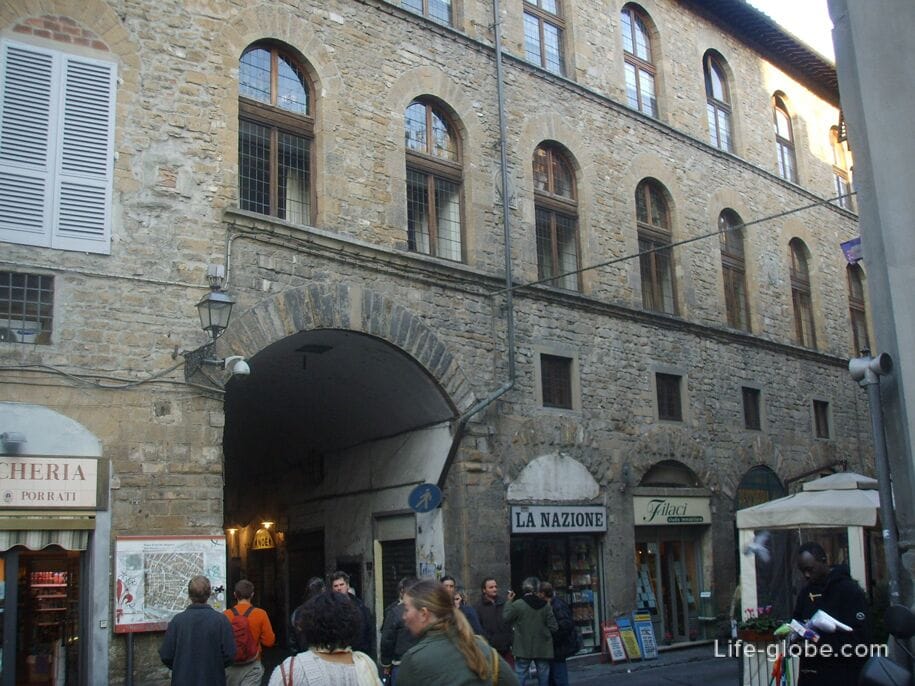
Photo of the loggia of the Church of San Pierre Maggiore on the square of San Pierre Maggiore
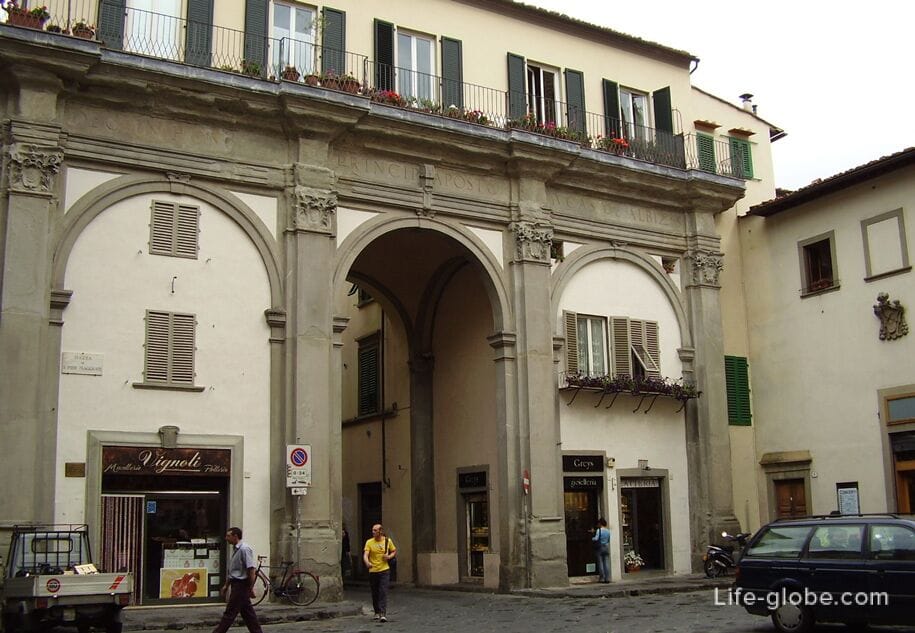
All accommodation facilities in Florence (hotels, apartments, guest houses, etc.), including those in the historical center of the city and more remotely from it, can be view and book here




